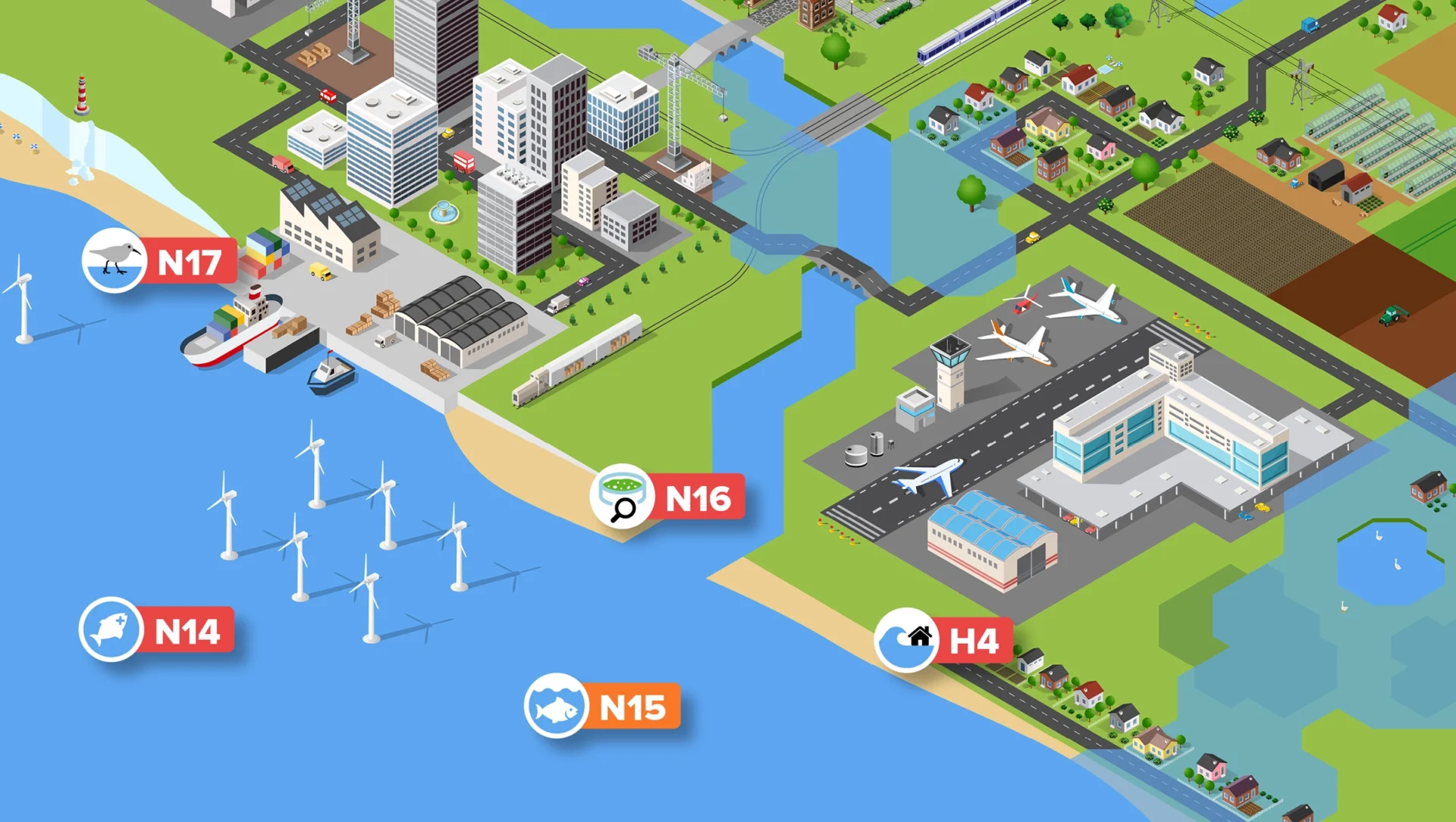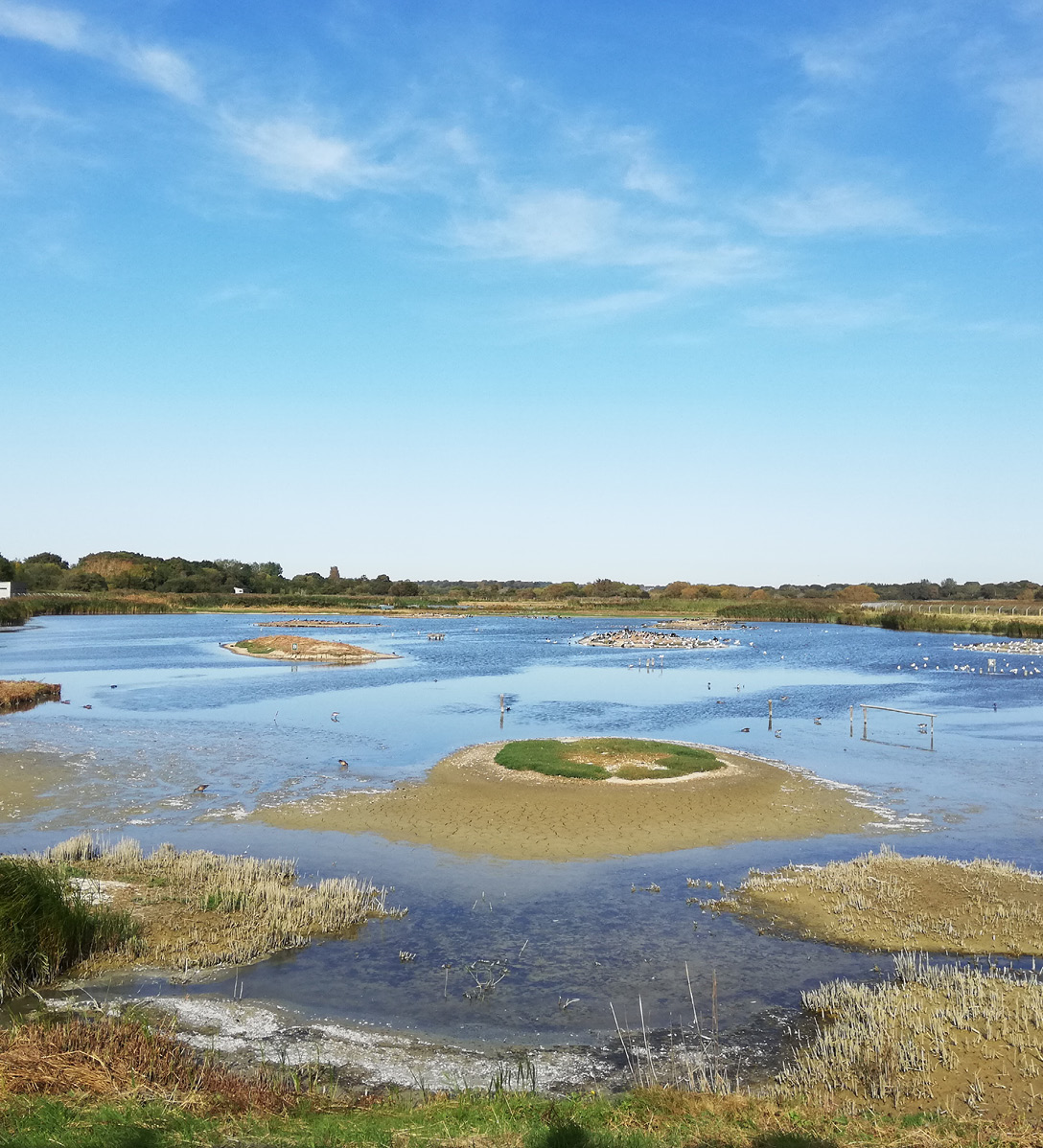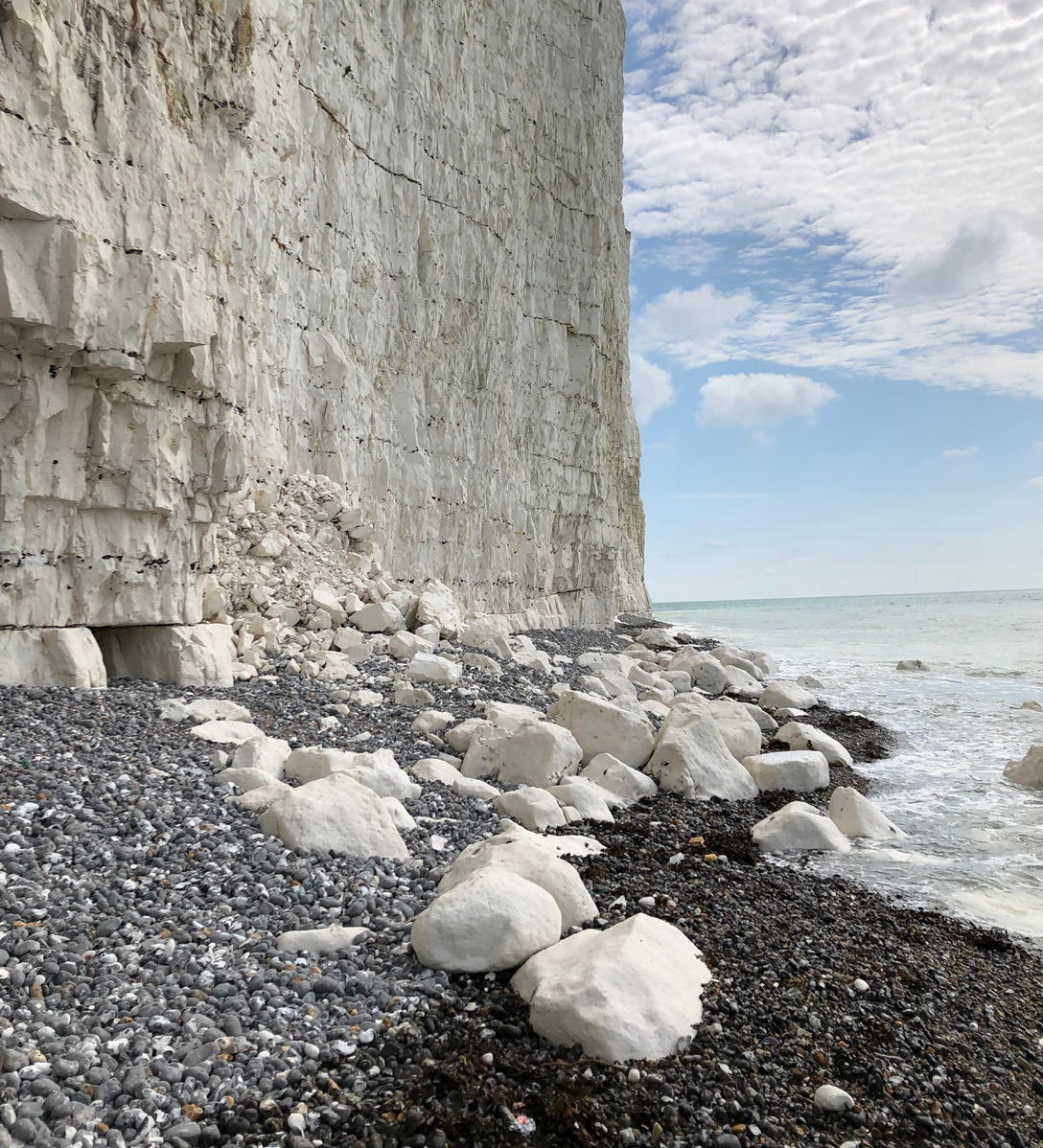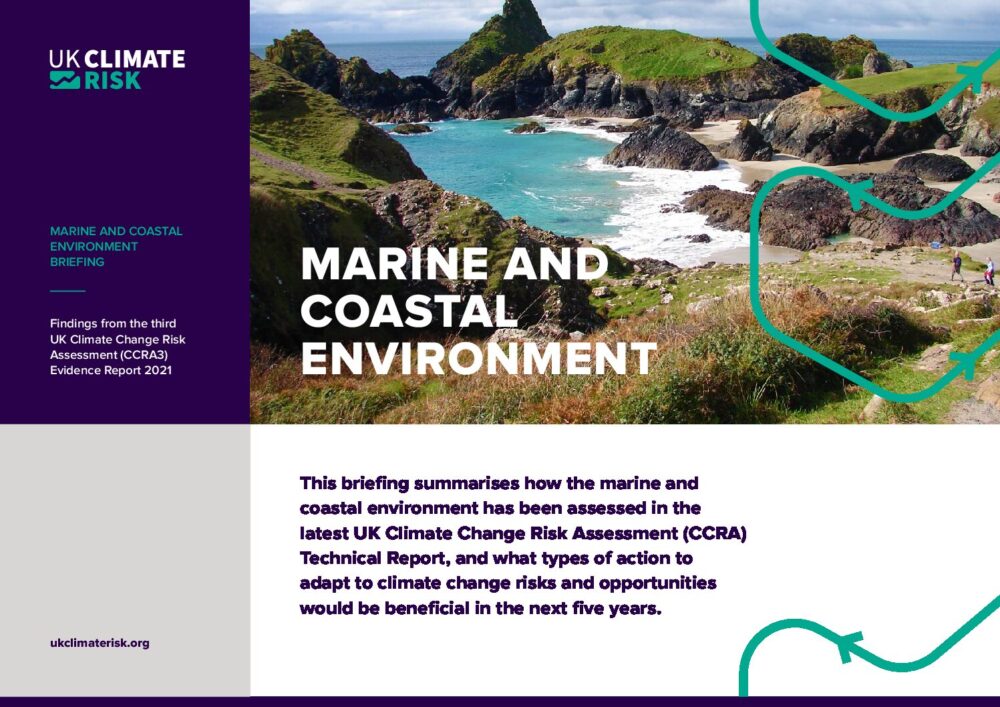Marine and Coastal Environment Briefing
About this document
Findings from the third UK Climate Change Risk Assessment (CCRA3) Evidence Report 2021
This briefing summarises how the marine and coastal environment has been assessed in the latest UK Climate Change Risk Assessment (CCRA) Technical Report, and what types of action to adapt to climate change risks and opportunities would be beneficial in the next five years.

This publication is available in PDF format at the end of the page >
The full assessment looks at risks and opportunities for the UK under two climate change scenarios, corresponding to approximately a 2°C or a 4°C rise in global temperature by 2100. It answers three questions, for 61 different risks or opportunities using available published evidence and analysis:
- What is the current and future level of risk or opportunity?
- Is the risk or opportunity being managed, taking account of government action and other adaptation?
- Are there benefits of further adaptation action in the next five years, over and above what is already planned?
The main findings from the full assessment related to the marine and coastal environment are summarised below, together with the adaptation actions that would be beneficial over the next five years.
Each risk or opportunity has an identifier code linked to the full analysis, which is available in the CCRA3 Technical Report. Readers are encouraged to use these briefings to locate the parts of the Technical Report of most relevance to them.
Alternatively, if you would like a summary of the analysis by UK nation, please go to the national summary documents:
This briefing is aimed primarily at the UK Government, the governments of Scotland and Wales, the Northern Ireland Assembly and their respective departments and agencies responsible for agriculture and food. However, it should also be of interest to a wider audience.
Key messages
- Significant thresholds could be exceeded, causing irreversible changes in the marine environment under both the 2°C and 4°C warming scenarios.
- Mean sea level has already risen around the UK by about 16cm from the start of the 20th Century and climate projections across the four nations predict a future sea level rise of between 0.27 and 1.12 metres by the end of the century, depending on global temperature rise.
- Marine ecosystems are already being impacted by climate change through both direct and indirect effects on the distribution and abundance of species groups, but it is hard to predict exactly which species will be affected the most in the future, and by how much.
- The arrival of different species into UK waters could also provide some new opportunities for fisheries, although details on such opportunities are limited.
- Risks from pests, pathogens and invasive non-native species (INNS) will increase in proportion to the degree of future marine warming but there is considerable uncertainty on how this will occur.
- Sea level rise will have impacts on coastal species and habitats. Negative impacts on coastal ecosystem services such as loss of habitats like sand dunes will have a knock-on effect on the economy, although there could be some opportunities for new habitat creation as well.
- Adaptations in the marine environment are challenging; reducing other pressures and enhancing protected sites will remain key and become increasingly important in the future.
Risks, opportunities, and benefits of further action

Average UK wide scores

N14. Risks to marine species, habitats and fisheries from changing climatic conditions, including ocean acidification and higher water temperatures.
More action needed

N15. Opportunities to marine species, habitats and fisheries from changing climatic conditions
Further investigation

N16. Risks to marine species and habitats from pests, pathogens and invasive species
More action needed

N17. Risks and opportunities to coastal species and habitats due to coastal flooding, erosion and climate factors
More action needed

H4. Risks to the viability of coastal communities from sea level rise
More action needed
1. Risks to marine species, habitats and fisheries from changing climatic conditions, including ocean acidification and higher water temperatures (N14)
Marine ecosystems will be impacted by climate change through both direct and indirect effects on the distribution and abundance of species groups. This includes the effects of warming seas and ocean acidification on the entire marine food chain, from plankton to invertebrates, fish, seabirds, marine mammals and their habitats.
Changes could include irreversible impacts to ecosystems from loss of species. Climate-related pressures on ‘blue carbon’ resources, i.e. those habitats and species that can store carbon, could also increase, resulting in this carbon becoming released and exacerbating the problem. For cold water corals and maerl beds, ocean acidification has potential to cause significant corrosion damage.
For fisheries, rapid range shifts greater than 4km per year are projected over the next century. Changes in fisheries policy, international trade and access to markets resulting from the UK’s departure from the EU is also likely to have major implications for how the fishing industry adapts to climate change.
The assessment gives a medium UK-wide risk now moving to high magnitude by the 2050s and beyond, including the risk of large-scale extinctions from threshold effects like marine heatwaves or deoxygenation.

Beneficial actions in the next five years include:
- Development and regulation of the UK’s Marine Protected Area network, considering expected future shifts in distributions of species.
- Consideration of the impact of the reduction of non-climate pressures, such as overfishing and pollution, to maximise potential for species and habitat resilience and restoration initiatives.
- A clearer assessment and implementation of sustainable fisheries yields in the context of present and future climate change.
- Improved monitoring schemes to better assess progress on biodiversity and fisheries’ goals in the context of climate change.
- Undertake further research on the climate sensitivity and interactions of plankton to fisheries, invertebrates, seabirds and mammals, as well as on the sensitivity of UK aquaculture species to multiple climate change drivers.
Further details on this risk: Natural Environment and Assets Technical Chapter, risk N14
2. Opportunities to marine species, habitats and fisheries from changing climatic conditions (N15)
The arrival of warm water species into UK waters could provide potential new opportunities for fisheries and will lead to changes in the biodiversity of UK seas.
Future climate projections indicate continued ocean warming to 2100 and beyond, with most projections in the range 0.2 to 0.4°C per decade. Hence, it is almost inevitable that there will be major changes in marine biodiversity and fisheries, with more warm-water species moving into UK waters as cold-water species are displaced.
Examples set out for this opportunity include marine mammals (such as striped dolphins) and commercial fish species (e.g. Northern hake). However, detailed evidence for individual species in terms of expected rates of change in occurrence and abundance remains limited and much of the adaptation opportunity for marine species and new fisheries remains unrealised. For any benefits of new species arriving, there will also be corresponding losses of other species.
The opportunity is given a medium magnitude rating now, increasing to high by the 2050s and beyond across the UK.

Beneficial actions in the next five years include:
- For protecting marine biodiversity, good habitat condition will be critical for maximising any opportunities for new species moving into UK waters and current marine plans and protected areas should be further developed to recognise this.
- For fisheries, undertake assessments linked to improved data on current and projected movements of key species together with sustainable yield assessments.
Further details on this opportunity: Natural Environment and Assets Technical Chapter, opportunity N15
3. Risks to marine species and habitats from pests, pathogens and invasive species (N16)

The scientific consensus is that risks from pests, pathogens and INNS will increase in proportion to the degree of future additional marine warming but there is considerable uncertainty on how this will occur, due in a large part to the scale and complexity of the marine environment.
Warming of UK shelf seas is projected to continue to 2100 and beyond with most projections indicating increases of between 0.2°C and 0.4°C per decade, but with regional differences and the greatest warming in the Channel and southern North Sea. In addition, many other stressors, including ocean acidification and changes in salinity levels due to stratification and modification of currents, are likely to continue, increasing the vulnerability of marine organisms to INNS or pathogens. Furthermore, at higher levels of climate change there is an increasing possibility of emergent unknown risks and irreversible change.
For commercial aquaculture, the impact of antimicrobial resistance (AMR) increasing in severity in association with climate warming is also an issue because antibiotics are commonly used in feedstuff to control bacterial infections.
The current risk magnitude is considered medium, increasing to high by the 2050s and beyond across the UK.

Beneficial actions in the next five years include:
- Collecting long-term data to better understand how marine pests, pathogens and INNS are affected by extreme events and climate change, alongside improved horizon scanning and modelling capability, including through international collaboration.
- Measures to prevent new introductions, including prioritising and managing pathways of marine INNS introduction.
- Increasing public awareness of INNS, including further use of citizen science to boost detection.
- Investigate factors that contribute to disease-resistant organisms, to take place alongside contingency planning for emergent risks, especially for novel pathogens.
Further details on this risk: Natural Environment and Assets Technical Chapter, risk N16
4. Risks and opportunities to coastal species and habitats (N17)
Coastal habitats occur at the boundary of terrestrial and marine environments and include saltmarsh, machair, shingle, sand dunes and sea cliffs.
These environments provide ecosystem services, such as flood and erosion protection, climate regulation and tourism opportunities, which were valued to be worth at least £48 billion in 2007, whilst in 2016 an indicative net present value over 50 years of £22.7 billion was calculated based upon those services that are more easily quantified.
The percentage of coastlines vulnerable to erosion across the UK are 28% in England and Wales, 19.5% in Northern Ireland and 19% in Scotland.
The current magnitude of risk/opportunity is medium rising to high by the 2050s and beyond for all four nations, especially due to the predicted magnitude of sea level rise.

Beneficial actions in the next five years include:
- Adaptation through effective implementation of nature-based solutions, including managed realignment and habitat restoration, to reduce risks and provide multiple benefits.
- Adaptation strategies should be designed to be more flexible and robust against the wider range of climate change projections, especially for higher rates and magnitudes of sea level rise.
- A system level change including a thorough review of current governance and delivery to ensure a strategic approach to managing long-term effects of coastal change on the UK coastline.
- Increase support for Coastal Observatories around the UK to coordinate research to help fill important evidence gaps that remain.
Further details on this risk and opportunity: Natural Environment and Assets Technical Chapter, risk/opportunity N17
5. Risks to the viability of coastal communities from sea level rise (H4)
This risk is focused on coastal change, that is, the physical change to the shoreline caused by coastal erosion, coastal landslip, permanent inundation or coastal accretion that is of such severity that the long-term sustainability and viability of coastal communities is threatened.
A summary of the associated risks is as follows:
- Parts of the south and east coasts of England and the west coast of Wales already face risks to their viability because of coastal erosion. Existing evidence does not indicate any coastal communities in Northern Ireland or Scotland have current risks to their viability.
- Current risks from erosion to UK properties or households are 8,900 (England), 2,720 (Northern Ireland), 212 (Scotland), and 400 (Wales).
- Future projections of coastal erosion are only currently available for England, suggesting up to 82,000 properties could be at risk by the end of the century.
- There are also no UK-wide projections of risk to the viability of coastal communities, either from erosion or catastrophic flooding.
- The magnitude of the risk to coastal community viability is currently considered low, but rises to high for England and Wales, and medium for Scotland and Northern Ireland by the end of the century.

Beneficial actions in the next five years include:
- Driving coastal flood and erosion management through integrated engineering, planning, insurance and preparedness activities, including consideration of where managed retreat (relocation away from the coast) might be necessary.
- Continuing the increasing emphasis on community or individual led activities to increase resilience.
- Further advances in mapping and modelling.
- Engaging local communities that have been identified as at risk, including through the provision of clear messages about how change will be delivered where this is needed. This, in turn, could bring in requirements in relation to the areas of national strategic planning, providing a legal adaptation planning framework, local delivery and funding, further community engagement, awareness raising and buy-in from community leaders.
- The CCRA technical chapters focus on the case study of the village of Fairbourne, where this process of transition to managed retreat is already underway.
Variations across the UK
| Risk or opportunity | England | Northern Ireland | Scotland | Wales |
| N14. Risks to marine species, habitats and fisheries from changing climatic conditions, including ocean acidification and higher water temperatures. | More action needed | More action needed | More action needed | More action needed |
| N15. Opportunities to marine species, habitats and fisheries from changing climatic conditions | Further investigation | Further investigation | Further investigation | Further investigation |
| N16. Risks to marine species and habitats from pests, pathogens and invasive species | More action needed | More action needed | More action needed | More action needed |
| N17. Risks and opportunities to coastal species and habitats due to coastal flooding, erosion and climate factors | More action needed | More action needed | More action needed | More action needed |
| H4. Risks to the viability of coastal communities from sea level rise | More action needed | Further investigation | More action needed | More action needed |
Background
The UK Government is required by the UK Climate Change Act 2008 to assess the risks and opportunities from climate change to the UK every five years and respond to the risks via a National Adaptation Programme, covering England. The devolved administrations also publish their own adaptation programmes in response to the risk assessment.
For this third UK Climate Change Risk Assessment, the Government’s independent advisers on climate change, the Climate Change Committee (CCC), have been asked to prepare an independent risk assessment setting out the latest evidence on the risks and opportunities to the UK.
Over 450 people from more than 130 organisations have contributed to preparing the assessment. The risks have been assessed using the latest climate projections for the UK which were updated in 2018 by the Met Office. These briefings summarise some of the key topics that are assessed through the Technical Report, to enable readers to understand the key messages and where to find more detail.
Where to find more detail
Each risk or opportunity in this briefing has an identifier code linked to the full analysis, which is available in the CCRA3 Technical Report. Readers are encouraged to use these briefings to locate the parts of the Technical Report of most relevance to them.
Alternatively, if you would like a summary of the analysis by UK nation, please go to the national summary documents:
Share on:

